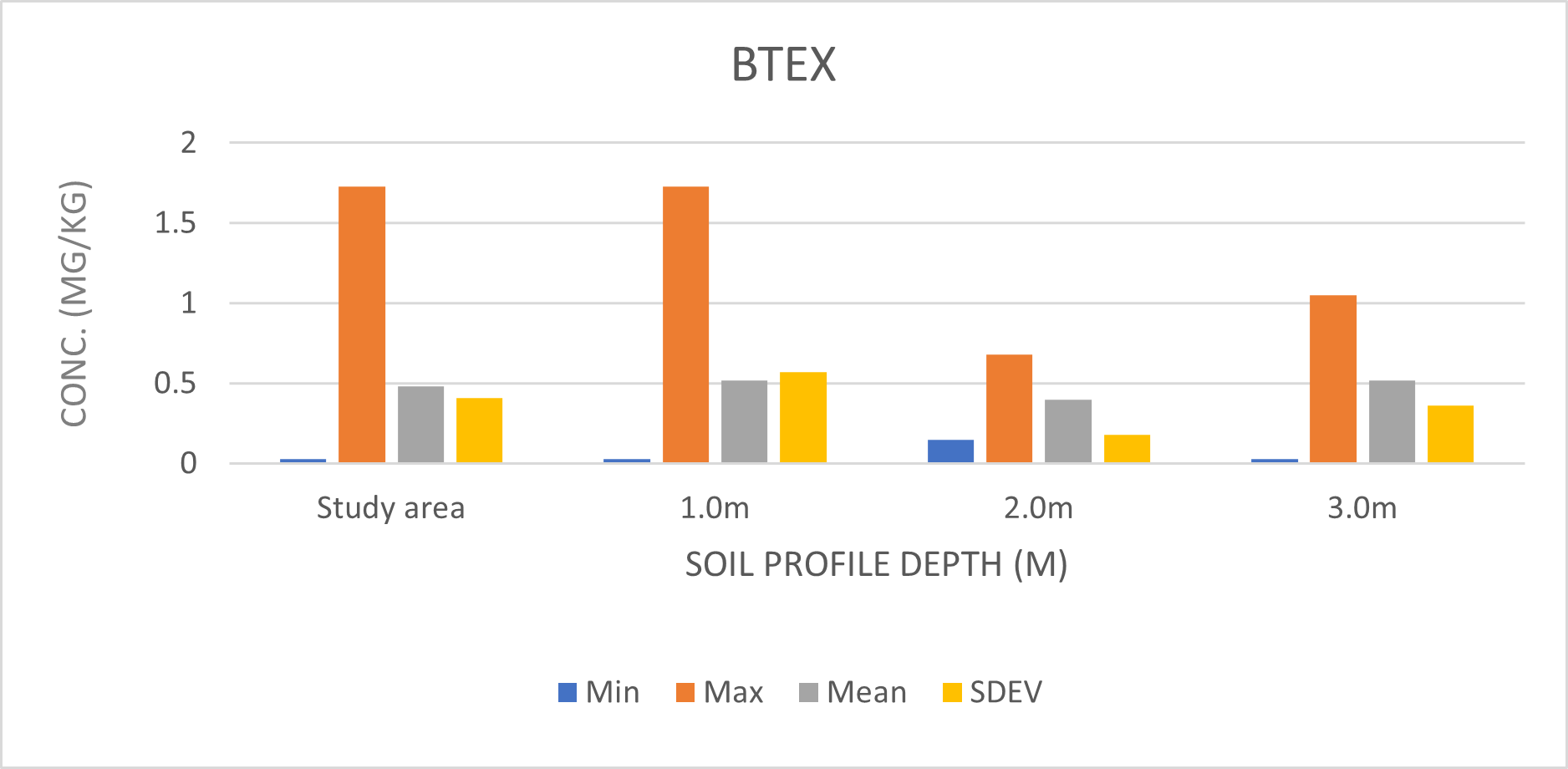Physicochemical Characterization of Oil Spill Impacted Soils in Emohua LGA of Rivers State
Keywords:
Oil Spill, Physicochemical, Agricultural, Food security, Characterization, SoilAbstract
Oil spillage on agricultural soil in the Niger Delta area of Nigeria is a serious threat to agricultural production and food security. This study was carried out to determine the effects of oil spillage on the physicochemical parameters of agricultural soils in Obele community of Emohua LGA. Thirty (30) triplicate soil samples at 3 depth (0-1.0, 1.1-2.0 and 2.1-3.0m) were collected from the study area and analyzed. The Physicochemical parameters were analyzed using standard methods and the results revealed that the total organic content (TOC) of the soils ranged from 0.28 – 1.29%. The lower levels observed may not be unconnected with the severe bush burning induced loss of organic matter at the location and the low level of vegetation cover. The pH values of the surface soils ranged from 4.50 – 5.9 making the soils acidic. The sulphate content (SO42-) of the surface and sub-surface soils at the location ranged from 0.013 – 1.25ppm while all the samples recorded low sulphate levels (<10ppm), most of the sample points recorded are considered extremely low sulphate levels (<0.1ppm). The nitrate content (NO3-) of the surface and sub-surface soils ranged from 0.14 – 1.47ppm. These values are also very low compared to the levels required for agricultural soils (15 -40ppm). These low levels will impact on the rate of biodegradation driven natural attenuation process. The phosphate (PO42-) content ranged between 0.015 – 2.819ppm. The values recorded were low as with the other agriculture/biologically critical anions. The suitable range for best biological function in soil is between 10-20ppm. This low-level like with sulphate and nitrate will negatively affect biodegradation. Sixteen (16) HA points out of 30 (53%) located predominantly at the periphery of the locations had TPH values >50ppm at a depth of 1.1-2m while a total of 14 HA points (46.7%) recorded TPH values >50ppm at depths of 2.1 – 3m. The study recommends cleanup and remediation efforts to mitigate the environmental impact of the oil spillage.

Published
How to Cite
Issue
Section
How to Cite
Most read articles by the same author(s)
- Stephen Osita Jonathan, Cyril Ngozi Nwankwo, Leo Nwosu, Delineation of Oil – Polluted Sites in Emohua LGA of Rivers State Using Resistivity and Induced Polarization Techniques , Nigerian Journal of Applied Physics: Vol. 1 No. 1 (2025): Nigerian Journal of Applied Physics - Vol. 1 No. 1
Similar Articles
- Stephen Osita Jonathan, Cyril Ngozi Nwankwo, Leo Nwosu, Delineation of Oil – Polluted Sites in Emohua LGA of Rivers State Using Resistivity and Induced Polarization Techniques , Nigerian Journal of Applied Physics: Vol. 1 No. 1 (2025): Nigerian Journal of Applied Physics - Vol. 1 No. 1
- Abdul Dahiru Buba, Clifford Chinedu Odiohamma, Medina Umar, Ramalan Abubakar, Sustainable Synthesis and Characterization of Graphene Nanosheets from Coconut Husk: A Green Approach for Advanced Materials , Nigerian Journal of Applied Physics: Vol. 1 No. 1 (2025): Nigerian Journal of Applied Physics - Vol. 1 No. 1
- Jude Oruaode Vwavware, Yakubu Mu’allim, Adrian Ohwofosirai, Okechukwu Austin Ojobeagu, The Impact of Robotic Telescopes on Time-Domain Astronomy , Nigerian Journal of Applied Physics: Vol. 1 No. 1 (2025): Nigerian Journal of Applied Physics - Vol. 1 No. 1
- Gideon Oluyinka Layade, Charles Olubunmi Ogunkoya, Hazeez Owolabi Edunjobi, Alex Israel Philip, Depth to Basement Mapping using Source Parameter Imaging (SPI): A Case Study from Federal University of Agriculture Abeokuta , Nigerian Journal of Applied Physics: Vol. 1 No. 1 (2025): Nigerian Journal of Applied Physics - Vol. 1 No. 1
- Aminu Ismaila, Yahaya Yamusa, Sunday A. Jonah, Ziyau Muhammad, Amadi Vincent Nnamdi, Determination of Epithermal Neutron Fluxes in the Cadmium-Lined Irradiation Channels of a Nuclear Reactor for Mineral Exploration , Nigerian Journal of Applied Physics: Vol. 1 No. 1 (2025): Nigerian Journal of Applied Physics - Vol. 1 No. 1
- Hyacinth Kevin Idu, Yusuf Cheyin Usman, Effects of Natural Fibre as Biomass Additive on the Structural and Mechanical Properties of High-Density Polyethylene Bio-Composite , Nigerian Journal of Applied Physics: Vol. 1 No. 1 (2025): Nigerian Journal of Applied Physics - Vol. 1 No. 1
You may also start an advanced similarity search for this article.




